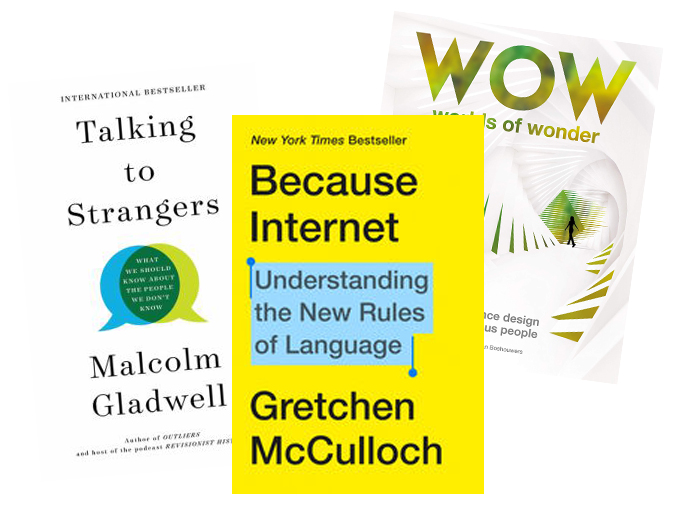Reviewed by Susan Fader, Fader & Associates, Teaneck, NJ, susanfader@faderfocus.com
Because Internet: Understanding the New Rules of Language by Gretchen McCulloch, Riverhead Books, 2019
WOW: Worlds of Wonder—Experience Design for Curious People by Erik Bär and Stan Boshouwers, BIS, 2019
Talking to Strangers by Malcolm Gladwell, Little, Brown, 2019
Communication can be tricky. Sometimes what you mean to convey is not what the person who is on the receiving end takes away. In face-to-face communication we have body language and tonality cues that help us contextualize what is being said. With online communication, we lose those in-person visual cues and the possibility of misinterpretation increases. Verbal and written communication have historically been the major forms of correspondence, but use of visual symbols (think emojis and GIFs) and experience design, which creates visual environments either in the “real” world or through virtual reality, are increasing in importance. However, no matter how carefully we craft any form of communication, and no matter the delivery mechanism, miscommunication and misinterpretation abound. As researchers, it is not just how we phrase questions, it is just as important to make sure our interpretation of what someone is saying matches the intended message. These three books tackle very different aspects of how to be a better communicator, observer, and listener.
How we communicate on the Internet is very different than how we communicate in face-to-face conversations. Gretchen McCulloch, an Internet linguist with extensive experience in this field, has written a very engaging book, Because Internet: Understanding the New Rules of Language, where she takes us on an interesting deep dive on the evolution of how online messages are crafted. The journey includes the whys and hows of changing word meaning, increased use of abbreviations, conscious misspellings, and the use of imagery (emojis and GIFs) in online conversations. It provides a guide to where the future of online communication is going.
One of the book’s most fascinating sections raised a serious red flag to me about assumptions that online words/phrases/visuals have universal meaning and how this fallacy could be negatively impacting data-mining findings. McCulloch shares multiple examples of how there are still significant U.S. regional and ethnic group online differences in choices of words/phrases/visuals usage and meaning that are much more serious than the pop/soda/cola choice of word differences. In the online world, the same word or phrase could have very different meanings depending on where it originates. McCulloch also traces the path of how phrases/visuals that may originate in one community can bypass whole sections and demographics of the U.S. when they next jump to a similar demographic community, e.g., Hispanic LA to Hispanic Miami. Then over time, they might migrate more into the mainstream. This book is a must-read.
Experience design is really spatial storytelling. Erik Bär and Stan Boshouwers have been involved in this field since 1991. Their book, WOW: Worlds of Wonder: Experience Design for Curious People, is immensely visual. It contains hundreds of beautiful full-color photographs coupled with well-written explanations that the authors use to tell their story and walk the reader through the what, why, how, and wow of experience design. The “what” section of the book provides the baseline for what experience design is. The “why” section includes multiple case studies. The “how” section, not surprisingly, gives you a step-by-step how-to, and the “wow” section is a play on the authors’ company name, Worlds of Wonder, and the wow effect that experience design can have. Even though I have no immediate opportunity to be involved in an experience design, I find that the visuals and the authors’ dialogue expand how I now see and experience public spaces. I really enjoyed this book.
While the first two books were detailed analyses of their topics, in Talking to Strangers, Malcolm Gladwell, the author of five previous best-sellers, including The Tipping Point, Blink, and Outliers, brings his signature storytelling/pop-science approach of explaining human behavior to the thesis of why miscommunication exists. While a number of his stories center around crimes, with some focusing on criminals (Bernie Madoff and Larry Nasser) and others on victims (Sandra Bland and Amanda Knox), not all of Gladwell’s stories are crime stories. Gladwell appears to have used “famous” people examples because he assumes that readers already know many of the backstories, so there is less for Gladwell to explain and thus it’s easier for him to point out communication missteps. This makes for an interesting and fast read.


Be the first to comment